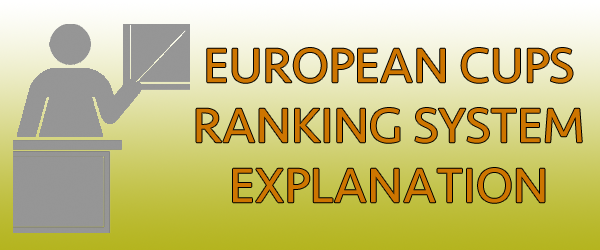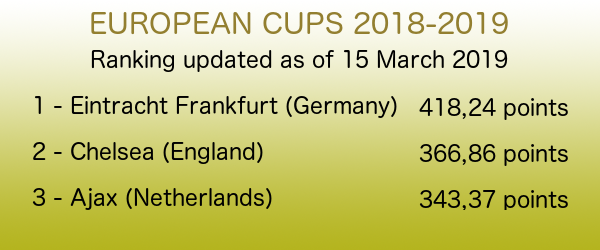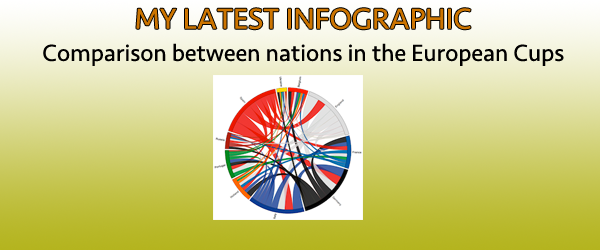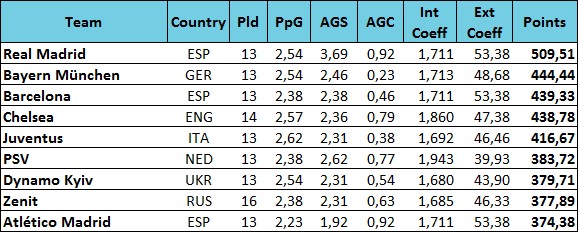I made a ranking about the ability of scoring or not conceding an equalizer.
The data are all from the current season, and refers to the domestic leagues of England, France, Germany, Italy, Portugal and Spain.
I took them from soccerstats.com
The first table refers to the ability to score an equalizer after having conceded a goal that gave the lead to the opponent.
I took into consideration only the teams who conceded a "leading goal" to the opponent a number of times equal at least to the 66% of the matches played.
MP = matches played
GGLO = number of goals that gave the lead to the opponents
EGS = number of equalizer goals scored by the team
ATE = ability to equalize (ratio between EGS and GGLO)
![[IMG]](http://nicolacerin.altervista.org/images/Equalizer-ate-20141231.jpg)
For example, Inter Milan played 16 matches this season, conceding 14 times a goal that gave the lead to their opponents, and 9 times they were able to equalize it. Their ability to equalize is then 64,29% (9/14).
The second table is about the ability to not conceding an equalizer after having taken the lead.
I took into consideration only the teams who scored a "leading goal" a number of times equal at least to the 66% of the matches played.
MP = matches played
GGL = number of goals that gave the lead to the team
EGC = number of equalizer goals conceded to the opponent
OATE = opponent's ability to equalize (ratio between EGC and GGL)
![[IMG]](http://nicolacerin.altervista.org/images/Equalizer-oate-20141231.jpg)
Real Madrid played 15 games, scored 15 "leading goals" and conceded only 2 equalizers to their opponents, for an OATE of 13.33% (2/15). When they take the lead of a match, they hardly lose it.
The data are all from the current season, and refers to the domestic leagues of England, France, Germany, Italy, Portugal and Spain.
I took them from soccerstats.com
The first table refers to the ability to score an equalizer after having conceded a goal that gave the lead to the opponent.
I took into consideration only the teams who conceded a "leading goal" to the opponent a number of times equal at least to the 66% of the matches played.
MP = matches played
GGLO = number of goals that gave the lead to the opponents
EGS = number of equalizer goals scored by the team
ATE = ability to equalize (ratio between EGS and GGLO)
![[IMG]](http://nicolacerin.altervista.org/images/Equalizer-ate-20141231.jpg)
For example, Inter Milan played 16 matches this season, conceding 14 times a goal that gave the lead to their opponents, and 9 times they were able to equalize it. Their ability to equalize is then 64,29% (9/14).
The second table is about the ability to not conceding an equalizer after having taken the lead.
I took into consideration only the teams who scored a "leading goal" a number of times equal at least to the 66% of the matches played.
MP = matches played
GGL = number of goals that gave the lead to the team
EGC = number of equalizer goals conceded to the opponent
OATE = opponent's ability to equalize (ratio between EGC and GGL)
![[IMG]](http://nicolacerin.altervista.org/images/Equalizer-oate-20141231.jpg)
Real Madrid played 15 games, scored 15 "leading goals" and conceded only 2 equalizers to their opponents, for an OATE of 13.33% (2/15). When they take the lead of a match, they hardly lose it.
Please note that a team could score or concede more than one "leading goal" and/or equalizer per game. Example: team A vs team B; team A scores the first goal of the match, going on 1-0; then team B equalizes to 1-1; then team A scores the 2-1, and team B scores the final 2-2. In this match, team A scored 2 goals that gave them the lead, and conceded 2 equalizers; viceversa for the team B, who scored 2 equalizers and conceded 2 goals that gave the lead to the opponent.
Ho creato una classifica riguardante l'abilità di segnare o di non subire una rete che porta al pareggio (equalizer).
I dati riguardano la stagione in corso, e si riferiscono ai campionati di Inghilterra, Francia, Germania, Italia, Portogallo e Spagna.
Ho preso i dati dal sito soccerstats.com
La prima tabella fa riferimento all'abilità di segnare il gol del pareggio dopo aver concesso alla squadra avversaria una rete che l'ha portata in vantaggio (d'ora in poi, "leading goal").
Ho preso in considerazione solamente le squadre che hanno concesso all'avversario un "leading goal" un numero di volte pari almeno al 66% delle partite giocate.
MP = partite giocate
GGLO = numero di reti che hanno portato l'avversario in vantaggio
EGS = numero di reti che hanno portato la squadra al pareggio
ATE = abilità di pareggiare (rapporto tra EGS e GGLO)
![[IMG]](http://nicolacerin.altervista.org/images/Equalizer-ate-20141231.jpg)
Per esempio, l'Inter ha giocato 16 partite finora, subendo 14 reti che hanno portato l'avversario in vantaggio, e riuscendo per 9 volte a pareggiare. La loro abilità di recuperare un vantaggio dell'avversario è quindi il 64,29% (9/14).
La seconda tabella si riferisce all'abilità di non concedere il gol del pareggio all'avversario, dopo essere passati in vantaggio.
Ho preso in considerazione solamente le squadre che hanno segnato un "leading goal" un numero di volte pari almeno al 66% delle partite giocate.
MP = partite giocate
GGL = numero di reti che hanno portato la squadra in vantaggio
EGC = numero di reti del pareggio concessi all'avversario
OATE = abilità dell'avversario di pareggiare (rapporto tra EGC e GGL)
![[IMG]](http://nicolacerin.altervista.org/images/Equalizer-oate-20141231.jpg)
Il Real Madrid ha giocato 15 partite, segnando 15 "leading goals" e concedendo solo 2 reti del pareggio, per un OATE del 13.33% (2/15). Quando i blancos passano in vantaggio, è quindi molto difficile riprenderli.
Nota bene: una squadra potrebbe segnare o subire più di un "leading goal" o "equalizer" durante la stessa partita. Esempio: squadra A contro squadra B; la squadra A segna per prima e va sull'1-0; la squadra B pareggia e va sull'1-1; la squadra A quindi segna il 2-1, e la squadra B segna il definitivo 2-2. In questa partita, la squadra A ha segnato 2 "leading goal", concedendo 2 reti del pareggio; al contrario, la squadra B ha segnato 2 reti del pareggio e ha concesso 2 "leading goal" all'avversario.






![[IMG]](http://nicolacerin.altervista.org/images/Goals_Scored_Trend_20141216.jpg)


![[IMG]](http://nicolacerin.altervista.org/images/FTS_AvgPTS_1415.jpg)
![[IMG]](http://nicolacerin.altervista.org/images/OSF_AvgPTS_1415.jpg)


